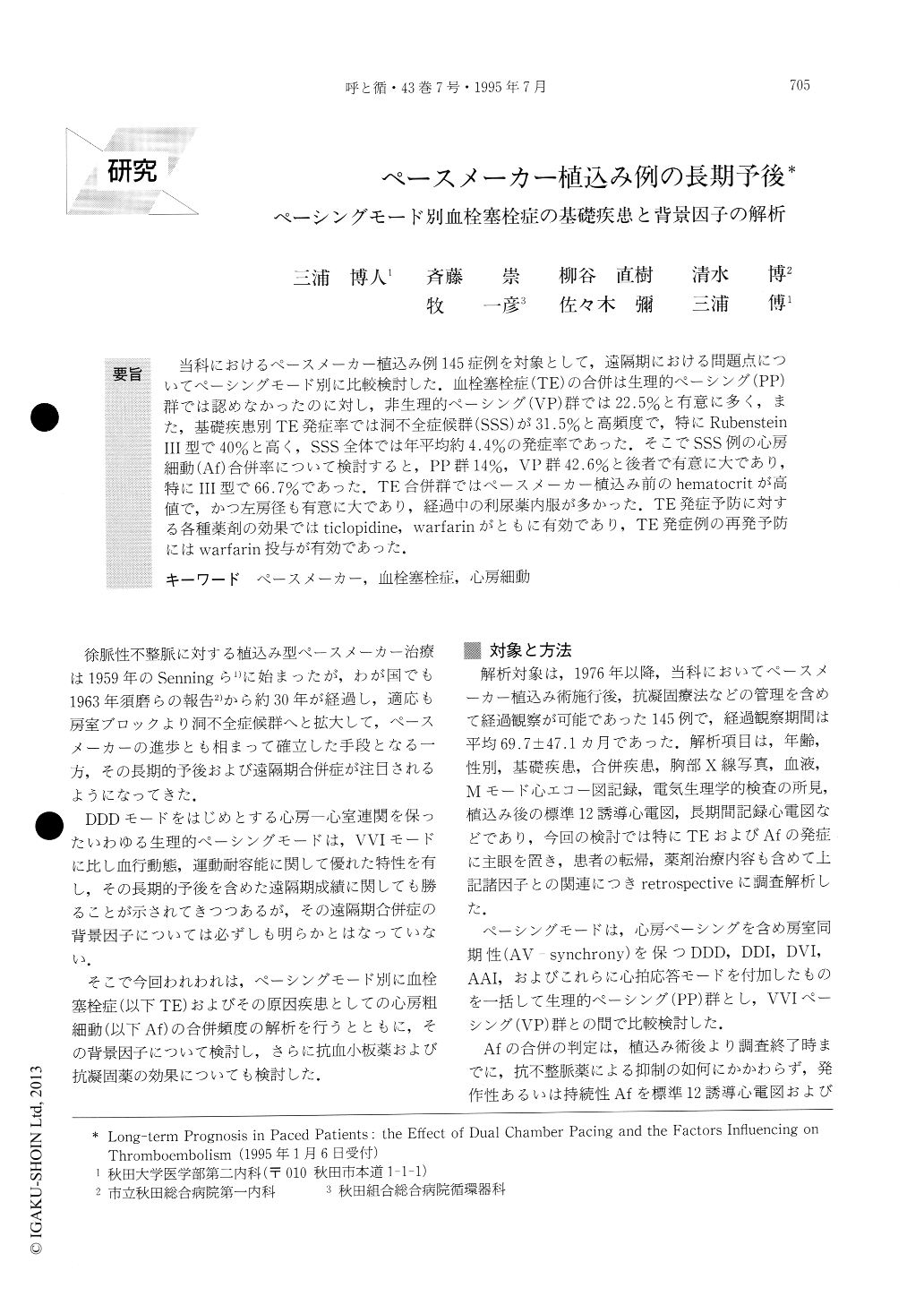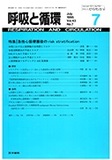Japanese
English
- 有料閲覧
- Abstract 文献概要
- 1ページ目 Look Inside
当科におけるペースメーカー植込み例145症例を対象として,遠隔期における問題点についてペーシングモード別に比較検討した.血栓塞栓症(TE)の合併は生理的ペーシング(PP)群では認めなかったのに対し,非生理的ペーシング(VP)群では22.5%と有意に多く,また,基礎疾患別TE発症率では洞不全症候群(SSS)が31.5%と高頻度で,特にRubensteinIII型で40%と高く,SSS全体では年平均約4.4%の発症率であった.そこでSSS例の心房細動(Af)合併率について検討すると,PP群14%,VP群42.6%と後者で有意に大であり,特にIII型で66.7%であった.TE合併群ではペースメーカー植込み前のhematocritが高値で,かつ左房径も有意に大であり,経過中の利尿薬内服が多かった.TE発症予防に対する各種薬剤の効果ではticlopidine,warfarinがともに有効であり,TE発症例の再発予防にはwarfarin投与が有効であった.
To elucidate the problem of long-term prognosis in paced patients with bradyarrhythmias, especially thromboembolism (TE) and atrial fibrillation (Af), we investigated the clinical records of 145 patients. Patients were divided into 2 groups, 80 patients with non-physiological pacing (VVI: referred to as group VP, included 54 with Sick Sinus Syndrome ; SSS and 26 with Atrioventricular Block; AVB) and 65 patients with physiological pacing (DDD, DDI, DVI and AAI: referred to as group PP, included 57 with SSS and 8 with AVB) from 1976 to 1993. The follow-up period after pacemaker implantation was 69.7±47.1 months.There was no significant difference in age, sex, pacing indications or underlying diseases between group VP and PP. 22.5% of patients in group VP had the compli-cation of TE, while no patients had TE in group PP (p<0.01). The incidence of TE was significantly higher in patients with SSS than in patients with AVB (31.5% vs. 3.8%, p<0.01), especially in patients with Ruben-stein type III (40.0%). The average incidence of TE was 4.4% per year in group VP with SSS. A similar high incidence of Af was also noticed in group VP compared to that in group PP (30.0% vs. 12.3%, p< 0.01) and in patients with SSS compared to those with AVB (42.6% vs. 3.8%, p<0.01). Background analyses revealed that the patients with TE had a higher hemato-crit level (40.5±4.7% vs. 37.6±4.3%, p<0.05), and a drug history of diuretics (47.1% vs. 18.9%, p<0.1). The cardiothoracic ratio, the left ventricular ejection frac-tion and the existence of ventriculo-atrial conduction was not statistically different, while the left atrial dimension determined by echocardiography was significantly greater in patients with TE (41.3±5.6mm)than in those without TE (37.7±5.1mm, p<0.05). We also compared the effect of anticoagulant therapy against TE after pacemaker implantation. Patients with SSS in group VP were divided into 4 subgroups; group A (no drugs), group B (anti-platelet drugs except for ticlopidine: aspirin, dipyridamole and toco-pherol), group C (ticlopidine) and group D (warfarin). The incidence of TE in these groups was 31%, 64%, 13% and 0%, respectively. And the recurrence rate of TE was 100%, 50% and 17% in group B, C and D, respec-tively. In conclusion, these results indicate that physio-logical pacing in patients with SSS is effective to pro-tect paced patients with SSS from TE by inhibiting the occurrence of Af, and that, where there is left atrial enlargement, high hematocrit and administration of diuretics are risk factors for TE. Our data endorse warfarin in preference to the other anti-platelet agents for the primary or secondary prevention of TE.

Copyright © 1995, Igaku-Shoin Ltd. All rights reserved.


